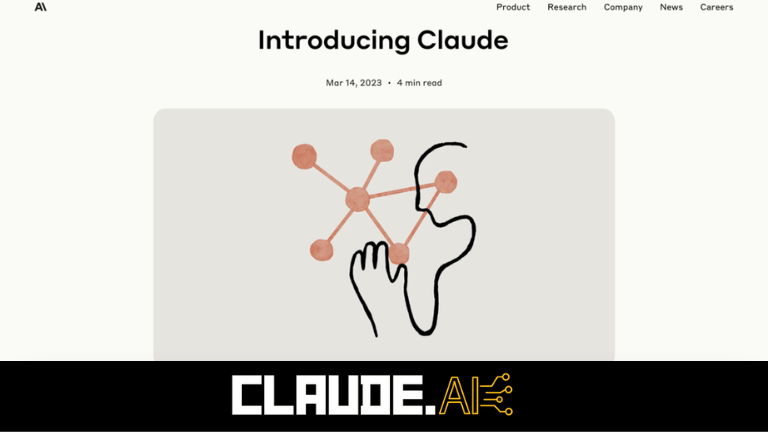What Architecture is Claude‘s LLM Based On? Conversational AI has seen rapid advancements in recent years thanks to innovations in large language models (LLMs). Companies like Anthropic have developed sophisticated conversational agents like Claude that can have natural conversations and be helpful personal assistants. But what exactly makes Claude tick under the hood? In this comprehensive blog post, we’ll take an in-depth look at the architecture behind Claude’s natural language capabilities.
Overview of Large Language Models
Claude is powered by an LLM at its core. LLMs are AI systems trained on massive text datasets to predict the next word in a sequence. They gain an understanding of language structure and meaning that allows them to generate coherent, human-like text. Prominent examples of LLMs include Google’s BERT, OpenAI’s GPT-3, and Anthropic’s Constitutional AI.
LLMs use an architecture called transformers, originally developed by researchers at Google Brain. Transformers are composed of encoder and decoder modules that process input text sequences in parallel rather than sequentially. This allows them to model longer-range dependencies in text compared to previous RNN architectures. Transformers proved incredibly effective for NLP tasks, causing a paradigm shift in the field.
Constitutional AI – The Foundation of Claude’s Abilities
Anthropic developed Constitutional AI as the backbone for Claude. Constitutional AI is an LLM trained using a technique called Constitutional AI to align its values with helpfulness, honesty, and harmless. This prevents potentially harmful behavior, making it safer for real-world deployment.
Constitutional AI utilizes self-supervised learning on massive unlabeled text data sets. This allows it to learn the statistical patterns of natural language without requiring extensive human labeling of training data. The system is fine-tuned on dialog data to optimize its conversational abilities.
Some key architectural features of Constitutional AI include:
- Transformer-based: Uses the transformer architecture to model long-range dependencies in text and dialogue. This allows coherent text generation.
- Attention mechanism: The transformers have multi-headed self-attention layers that identify relevant context in the input for each output word. This gives appropriate, context-aware responses.
- Scaled architecture: Constitutional AI scales up model size compared to predecessors like GPT-3 for greater reasoning ability.
- Sparse activations: Uses an activation sparsity technique to increase efficiency and throughput while maintaining model quality.
- Alignment methods: Novel techniques like debate and distributional constraints steer model behavior towards Constitutional AI goals like helpfulness.
By fine-tuning this architecture on dialog data sets and using alignment methods, Constitutional AI becomes optimized as an assistant capable of natural, trustworthy conversations.
Claude’s Modular, Pipeline Architecture
While Constitutional AI forms the foundation, Claude incorporates additional components for a robust conversational experience:
Pre-Processing
- Speech recognition: For voice queries, Claude converts speech to text via automated speech recognition. Google’s wav2vec 2.0 model handles this step.
- Intent recognition: Understands the user’s intent from text using natural language understanding techniques like semantic parsing.
Dialogue Management
- State tracking: Keeps track of context and conversation history to give appropriate, consistent responses.
- Response generation: Generates text responses using Constitutional AI conditioned on the intent and conversation state.
- Sentiment analysis: Detects user sentiment to tailor tone of responses. Claude aims for positive interactions.
Post-Processing
- Speech synthesis: Converts generated text back to naturalistic speech for voice interactions. Claude uses a DeepVoice-like model for this.
- Response filtering: As a safety measure, filters out any concerning or inappropriate responses before delivery.
Knowledge Access
- Information retrieval: Retrieves relevant information from Claude’s knowledge base to answer many user queries.
- Web access: For requests requiring outside information, Claude can query the internet and process web results.
Bringing together all these components enables Claude AI to handle the full pipeline of conversational interactions – from speech and intent recognition to knowledge inclusion and response delivery. The result is a smooth, natural assistant experience.
Training Approach for Conversational Excellence
In addition to its architecture, Claude’s training process sets it apart from other conversational AI:
- Self-supervised pre-training: The base Constitutional AI model learns broad language capabilities from unlabeled data before task-specific fine-tuning.
- Goal-oriented dialogue: Further pre-training on dialog data maximizes conversational abilities like coreference resolution and consistency.
- Reinforcement learning: Optimizes model parameters for dialogue policies that result in positive interactions and user satisfaction.
- Imitation learning: Learns from human conversational data to mimic cooperative, helpful dialog strategies.
- Interactive training: Claude’s training includes live human conversations to learn directly from users. This develops its “bedside manner” for friendly interactions.
- Ongoing learning: Claude continues to learn and improve from new user conversations. This allows it to expand its knowledge and conversational skills over time.
This multi-faceted training approach develops Claude into a capable, natural-sounding assistant optimized for cooperative dialogue. The system keeps learning to create even more positive user experiences.
Advantages of Claude’s Architecture
Claude’s conversational architecture powered by Constitutional AI offers significant advantages:
- Helpful assistance: The alignment techniques steer Claude’s responses to be useful, honest, and harmless – key for a digital assistant.
- Broad capabilities: The large Constitutional AI model paired with web knowledge enables Claude to engage on most topics.
- Personalized interactions: Claude’s training aims to make conversations feel natural and friendly, avoiding robotic responses.
- Consistent persona: State tracking and coreference capabilities allow consistent personality and memory across conversations.
- Safety: Filters and testing mechanisms maximize response quality and safety for real-world use.
- Efficiency: Claude can conduct multiple conversations simultaneously thanks to the efficiency of sparse transformer architectures.
- Improving abilities: Ongoing learning and reinforcement techniques will continue advancing Claude’s conversational skills over time.
These advantages make Claude a leading example of assimilating cutting-edge AI research into beneficial, trustworthy assistants. Anthropic’s thoughtful architecture paves the way for more positive human-AI interactions.
The Future of Conversational AI
Claude represents significant progress, but there is still much room for advancement. Here are some promising directions for conversational AI research:
- Deeper reasoning: Architectures incorporating more explicit reasoning, logic, and knowledge representation will enable assistants to handle more complex conversations and queries.
- Multi-modal capabilities: Combining language with other modalities like vision will allow assistants to understand the full context of the physical world.
- Social intelligence: More natural models of theory of mind, social reasoning, and emotion can make conversations more intuitive.
- Personalization: Fine-tuning on individual user data and contexts could produce assistants specialized for each person.
- Scalability: Advances in efficient training and inference will enable conversational models with even broader knowledge and abilities.
- Transparency: Improving model interpretability and explainability will be important for understanding capabilities and building appropriate trust.
Anthropic Constitutional AI and Claude are important steps toward these goals. With responsible development, conversational AI can become an even more helpful complement to human intelligence in the future.
Conclusion
To create Claude’s natural conversational abilities, Anthropic leveraged the power of large language models along with critical safety mechanisms. Constitutional AI provides a broad language understanding, while Claude’s pipeline architecture enables smooth dialogue interactions. Ongoing improvements from Anthropic’s research will likely further advance Claude’s capabilities for friendly, trustworthy assistance. As one of the leading conversational AIs today, Claude paves the way for more beneficial human-AI collaboration in the future.

FAQs
What type of neural network architecture does Claude use?
Claude uses a transformer-based architecture, which is well-suited for natural language processing tasks. Specifically, it uses Anthropic’s Constitutional AI model.
How large is Claude’s neural network?
The full size of Claude’s model is proprietary information held by Anthropic. However, it is likely a large model with billions of parameters, on par with models like GPT-3.
Does Claude use supervised or unsupervised learning?
Claude relies on both supervised and unsupervised learning. It is pretrained in an unsupervised manner on large text corpora, then fine-tuned on dialog data through supervised learning.
What is the purpose of Claude’s attention mechanism?
The attention layers help Claude focus on the most relevant parts of the conversational context when generating each response. This results in more appropriate, on-topic responses.
How does Claude track conversation state and history?
Claude maintains an internal representation of the conversation, remembering facts and context from previous turns. This state tracking allows it to hold consistent dialogs.
Why is Claude’s architecture sparsely activated?
Sparsity boosts efficiency and throughput without sacrificing too much model performance. This allows Claude to handle multiple conversations in parallel.
How does Claude incorporate external knowledge?
Claude has access to a knowledge base along with the ability to query the internet for information outside its knowledge, enabling it to answer more questions.
What is Claude’s approach to sentiment analysis?
Claude detects user sentiment and emotion using NLP techniques. It aims to respond positively and offer reassurance when users express negativity.
How does Claude filter inappropriate responses?
Potentially concerning responses are flagged through classifiers and blocked before being returned to the user as a safety mechanism.
How does Claude convert text to speech?
Claude uses a WaveNet-style deep neural network for high-quality text-to-speech synthesis to power voice interactions.
Does Claude use goal-oriented dialogue training?
Yes, Claude is trained expressly for goal-oriented conversations, learning dialogue policies optimized for being helpful to users.
What is reinforcement learning’s role in Claude’s training?
Reinforcement learning allows Claude to improve its dialogue management skills through trial-and-error interactions.
How does Claude learn from real human conversations?
Interactive training with humans provides data for imitation learning, teaching Claude cooperative conversation strategies.
Can Claude adapt to individual users over time?
Yes, Claude can personalize conversations by fine-tuning its model on an individual user’s conversational history and preferences.
How does Claude’s architecture ensure safety?
Multiple strategies like response filtering, debiasing, and oversight from Anthropic researchers ensure Claude acts safely and ethically.

